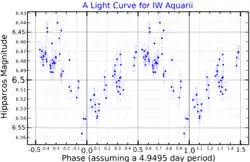| Observation data Epoch J2000 Equinox J2000 | |
|---|---|
| Constellation | Aquarius |
| Right ascension | 21h 16m 17.7734s[2] |
| Declination | −09° 12′ 52.795″[2] |
| Apparent magnitude (V) | 6.44 - 6.55[3] |
| Characteristics | |
| Spectral type | M4III:[4] |
| B−V color index | 1.57[5] |
| Variable type | Semiregular[4] |
| Astrometry | |
| Radial velocity (Rv) | 8.00[6] km/s |
| Proper motion (μ) | RA: −1.597[2] mas/yr Dec.: +3.549[2] mas/yr |
| Parallax (π) | 2.4622 ± 0.0685 mas[2] |
| Distance | 1,320 ± 40 ly (410 ± 10 pc) |
| Absolute magnitude (MV) | −2.3[4] |
| Details[2] | |
| Mass | 1.9 M☉ |
| Radius | 106 R☉ |
| Luminosity | 2,145 L☉ |
| Surface gravity (log g) | +0.36 cgs |
| Temperature | 3,542 K |
| Metallicity [Fe/H] | −0.4 dex |
| Age | 1.5 Gyr |
| Other designations | |
| Database references | |
| SIMBAD | data |
14 Aquarii (abbreviated 14 Aqr) is red giant star. 14 Aquarii is the Flamsteed designation; it also bears the variable star designation IW Aquarii. It is a semiregular variable with an amplitude of a tenth of a magnitude, and shows variations on a timescale of just one day.[4]
References
- ↑ "/ftp/cats/more/HIP/cdroms/cats". Centre de Données astronomiques de Strasbourg. Strasbourg astronomical Data Center. Retrieved 15 October 2022.
- 1 2 3 4 5 6 Vallenari, A.; et al. (Gaia collaboration) (2023). "Gaia Data Release 3. Summary of the content and survey properties". Astronomy and Astrophysics. 674: A1. arXiv:2208.00211. Bibcode:2023A&A...674A...1G. doi:10.1051/0004-6361/202243940. S2CID 244398875. Gaia DR3 record for this source at VizieR.
- ↑ "14 Aqr". International Variable Star Index. AAVSO. Retrieved 2022-11-21.
- 1 2 3 4 Koen, Chris; Laney, Dave (2000). "Rapidly oscillating M giant stars?". Monthly Notices of the Royal Astronomical Society. 311 (3): 636. Bibcode:2000MNRAS.311..636K. doi:10.1046/j.1365-8711.2000.03127.x.
- ↑ Høg, E.; Fabricius, C.; Makarov, V. V.; Urban, S.; Corbin, T.; Wycoff, G.; Bastian, U.; Schwekendiek, P.; Wicenec, A. (2000). "The Tycho-2 catalogue of the 2.5 million brightest stars". Astronomy and Astrophysics. 355: L27. Bibcode:2000A&A...355L..27H. doi:10.1888/0333750888/2862.
- ↑ Kharchenko, N. V.; Scholz, R.-D.; Piskunov, A. E.; Röser, S.; Schilbach, E. (2007). "Astrophysical supplements to the ASCC-2.5: Ia. Radial velocities of ˜55000 stars and mean radial velocities of 516 Galactic open clusters and associations". Astronomische Nachrichten. 328 (9): 889. arXiv:0705.0878. Bibcode:2007AN....328..889K. doi:10.1002/asna.200710776. S2CID 119323941.
External links
This article is issued from Wikipedia. The text is licensed under Creative Commons - Attribution - Sharealike. Additional terms may apply for the media files.
